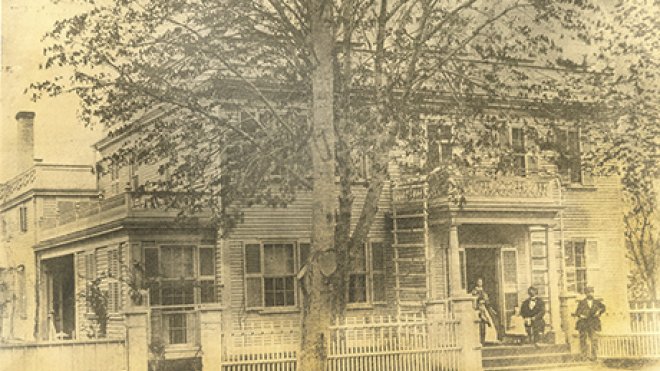From Past to Present: Photographs Explore Change in Bristol
A Roger Williams University project, in collaboration with the Bristol Historical & Preservation Society and Bristol Art Museum, examines town’s evolution throughout history in photographic exhibition and panel discussion

BRISTOL, R.I. – In the case of the Longfield house, a circa-1850 home designed by the famous architect Russell Warren, the once-paragon of Gothic Revival now haunts its Hope Street post, gutted and in disrepair. By contrast, the Belvedere Hotel in central downtown has endured its share of knocks – from the 1938 Hurricane to a disastrous fire – yet reclaimed its grandeur at the turn of the century when it was restored into upscale residences.
An exhibition featuring archival and contemporary images, Bristol: Past & Present examines these landmarks and more, documenting the town’s evolution over time via historic images, prints and maps of Bristol’s landmarks and significant properties contrasted alongside the same scenes in new photography. It is, at once, a glimpse at what once was and how the 268-year-old community – widely known as “America’s most patriotic town” for its centuries old Independence Day celebration – appears today.
The exhibit is the capstone of a new course at Roger Williams University in collaboration with the Bristol Historical & Preservation Society and Bristol Art Museum via RWU’s Community Partnerships Center. Students researched Bristol’s most historic properties, collected archival images and captured new photography to explore the town’s expansion and historic preservation. A month-long exhibit at the Bristol Art Museum will be open to the public, and kicks off with an opening reception on Nov. 20; all photographs will be turned over to the Town of Bristol at the exhibit’s conclusion for use in perpetuity.
“This project presents an opportunity for us as a community to assess the changes that have occurred,” says Stephan Brigidi, an adjunct professor at Roger Williams who led the course. “Some are quite positive – where citizen-led efforts have preserved important properties that are iconic to the town – and some are contentious, if not controversial, and remain open for discussion.”
A panel discussion on Sunday, Dec. 6 will provide an open forum to consider these ideas against the backdrop of the exhibition. Presenters include Brigidi; Professor Emeritus of Historic Preservation Kevin Jordan; Visiting Associate Professor of Historic Preservation Catherine Zipf; and the student photographers. The panel will be held at 2 p.m. at the Bristol Art Museum.
In their research, the dozen students delved into the archives of the Bristol Historical & Preservation Society, Rogers Free Library, East Bay Newspapers and the RWU Library; they also procured historic images from the collections of the late Lombard Pozzi, an esteemed restoration architect and Bristol resident, and town historian Richard Simpson.
Students also interviewed two longtime residents – Joan Roth, a native Bristolian integral in many local preservation efforts, and Antonio Teixeira, the town administrator with deep roots in the large Portuguese community – and created visual histories of their reflections on how the town has developed during their lifetimes. These oral histories will be screened at the exhibition, along with multimedia presentations of the students’ historic research.
When approaching their research subjects as photographers, the students’ first objective was to recreate angle and composition in order to contrast perspectives from one era to the present. They then captured new, creative interpretations of each setting. Most students snapped digital photos, while one worked in film and another produced aerial photography.
For Scott McDavid, a senior international relations major and French minor, his aim in photographing the 1860 barn at Mount Hope Farm – one of his many contributions to the project – was to demonstrate the essence of historic preservation in the handsomely restored building that serves as the indoor winter farmers market and event space.
“I first photographed the barn straight on to show how little it’s changed over the years,” McDavid says. “Then I photographed it at 45 degrees, where you can see the new addition, and contrast the old and new in its present-day form – the complementary effect of the gray, weathered wood in the older part and the fresh, new wood look on the addition.”
According to Brigidi, the exhibit’s collection of nearly 100 images reveals gradual alterations to some properties, such as Mount Hope Farm whose historic architecture remains nearly entirely intact, and radical transformations to others. Bygone scenes of a thriving yacht-manufacturing business give way to today’s Herreshoff Marine Museum, which exhibits the legendary vessels once made by scores of skilled craftsmen. In contrast, the Pastime Theater, destroyed by fire in 1934, was first rebuilt into a 600-seat cinema and then demolished in 2007 to construct the expanded Colt Andrews Elementary School.
“Even though we’re focusing on Bristol’s past and present, we’re also being mindful of the future and hope that this project will lend some thought to decisions about the town’s future,” Brigidi says. “Perhaps this project will inspire people about historic preservation and to give careful thought before taking down a building and putting up a new structure.”
The Bristol: Past & Present exhibit is dedicated to Lombard Pozzi – “a great friend of Bristol who was instrumental in many local restoration efforts,” according to Brigidi. The project was made possible by a grant from the Rhode Island Council for the Humanities.
Members of the public are welcome to attend the opening reception on Friday, Nov. 20, from 7:00 to 9:00 p.m. at the Bristol Art Museum. The exhibition will be open to the public during museum hours through Sunday, Dec. 20.